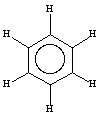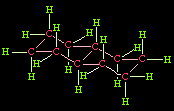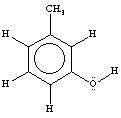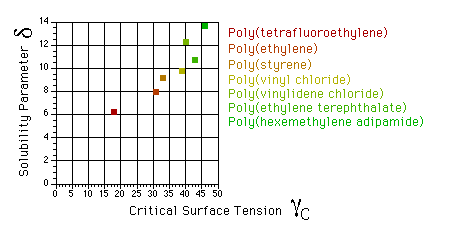Acetone

Benzene

Decalin
What trans-Decalin looks like with the hydrogens shown

cis-decalin

trans-decalin

m-Cresol

Diethyl Ether

Methyl Ethyl Ketone

Water


Last Update- July 20, 1995- wld
chemical solubility
parameter
decafluorobutane 10.6
neopentane 12.9 A A letter next to the solvent
n-hexane 14.9 A solubility parameter indicates
diethyl ether 15.1 that the polymer corresponding
cyclohexane 16.8 A to the letter (listed below)
carbon tetrachloride 17.6 A B dissolves in the solvent.
benzene 18.8 A B
chloroform 19.0 A B C
methyl ethyl ketone 19.0 B C
actone 20.3 B C
carbon disulfide 20.5
1,4-dioxane 20.5 B C
dimethylformamide 24.8 B C (D) (at high temperatures only)
m-cresol 27.2 B C D
formic acid 27.6 B D
methanol 29.7
water 47.9
A Poly(isobutylene) 16.2
B Poly(methylmethacrylate) 18.6
C Poly(vinyl acetate) 19.2
D Poly(hexamethylene adipamide) 27.8
Poly(tetrafluoroethylene) (Teflon(tm)) 6.2 Poly(ethylene) 7.9 Poly(styrene) 9.1 Poly(vinyl Chloride) 9.7 Poly(vinylidene Chloride) 12.2 Poly(ethylene Terephthalate) 10.7 Poly(hexemethylene Adipamide) 13.6
solvent nature delta nature of hydrogen bonding
n-Hexane 7.4 poor (Encyc. Polym. Tech. reports 14.9)
Diethyl Ether 7.4 moderate (Encyc. Polym. Tech. reports 15.1)
Diisobutyl Ketone 7.8 moderate
Cyclohexance 8.2 poor (Encyc. Polym. Tech. reports 16.8)
Carbon Tetrachloride 8.6 poor (Encyc. Polym. Tech. reports 17.6)
Toluene 8.9 poor
4-Heptanone 8.9 moderate
Methyl Hexyl Ketone 8.9 moderate
Chloroform 9.3 poor
Methyl Ethyl Ketone 9.3 moderate
2-Ethyl Hexanol 9.5 strong
Ethylene Dichloride 9.8 poor
Acetone 10.0 moderate
Nitropropane 10.4 poor
2-Ethyl Butanol 10.5 strong
Methyl Cellosolve 10.8 moderate
Nitroethane 11.1 poor
n-Butanol 11.4 strong
Isopropanol 11.5 strong
Acetonitrile 11.9 poor
Ethanol 12.7 strong
Propylene carbonate 13.3 moderate
Methanol 14.5 strong
Ethylene carbonate 14.7 moderate
Water 23.4 strong (Encyc. Polym. Tech reports 47.9)
In nearly every case Encyc. Polym. Tech's number
is double the number given here by an article in JAPS.
Note on the graph below that there is a somewhat linear trend between
the Hildebrand solubility parameter and the critical surface tension.









